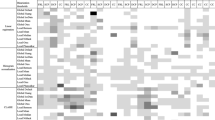Abstract
•Background: The influence of the contour line alignment software algorithm on the variability of the Heidelberg Retina Tomograph (HRT) parameters remains unclear. •Methods: Nine discrete topographic images were acquired with the HRT from the right eye in six healthy, emmetropic subjects. The variability of topometric data obtained from the same topographic image, analyzed within different samples of images, was evaluated. A total of four mean topographic images was computed for each subject from: all nine discrete images (A), the first six of those images (B), the last six of those nine images (C), and the first three combined with the last three images (D). A contour line was computed on the mean topographic image generated from the nine discrete topographic images (A). This contour line was then applied to the three other mean topographic images (B, C, and D), using the contour line alignment in the HRT software. Subsequently, the contour line on the mean topographic images was applied to each of the discrete members of the particular images subsets used to compute the mean topographic image, and the topometric data for these discrete topographic images was computed successively for each subset. Prior to processing each subset, the contour line on the discrete topographic images was deleted. This strategy provided a total of three analyses on each discrete topographic image: as a member of the nine images (mean topographic image A), and as a member of two subsets of images (mean topographic image B, C, and/or D). The coefficient of variation (100×SD/mean) of the topographic parameters within those three analyses was calculated for each discrete topographic image in each subject (“intraimage” coefficient of variation). In addition, a coefficient of variation between the nine discrete topographic images (“interimage” coefficient of variation) was calculated. •Results: The “intraimage” and “interimage” variability for the various topographic parameters ranged between 0.03% and 3.10% and between 0.03% and 24.07% respectively. The “intraimage” coefficients of variation and “interimage” coefficients of variation correlated significant (r 2=0.77;P<0.0001). •Conclusion: A high “intraimage” variability, i.e. a high variability in contour line alignment between sequential images, might be an important source of test re-test variability between sequential images.
Similar content being viewed by others
References
Chauhan BC, McCormick TA (1995) Effect of the cardiac cycle on topographic measurements using confocal scanning laser tomography. Graefe's Arch Clin Exp Ophthalmol 233:568–572
Chauhan BC, LeBlanc RP, McCormick TA, Rogers JB (1994) Testretest variability of topographic measurements with confocal scanning laser tomography in patients with glaucoma and control subjects. Am J Ophthalmol 118:9–15
Dreher AW, Weinreb RN (1991) Accuracy of topographic measurements in a model eye with the laser tomographic scanner. Invest Ophthalmol Vis Sci 32:2992–2996
Hosking SL, Flanagan JG (1996) Prospective study design for the Heidelberg Retina Tomograph: the effect of change in focus setting. Graefe's Arch Clin Exp Ophthalmol 234:306–310
Kruse FE, Burk RO, Volcker HE, Zinser G, Harbarth U (1989) Reproducibility of topographic measurements of the optic nerve head with laser tomographic scanning. Ophthalmology 96:1320–1324
Lusky M, Bosem ME, Weinreb RN (1993) Reproducibility of optic nerve head topography measurements in eyes with undilated pupils. J Glaucoma 2:104–109
Mikelberg FS, Wijsman K, Schulzer M (1993) Reproducibility of topographic parameters obtained with the Heidelberg Retina Tomograph. J Glaucoma 2:101–103
Orgül S, Cioffi GA, Bacon DR, Van Buskirk EM (1996) Sources of variability of topometric data with a scanning laser ophthalmoscope. Arch Ophthalmol 114:161–164
Rohrschneider K, Burk ROW, Vö1ker HE (1993) Reproducibility of topometric data acquisition in normal and glaucomatous optic nerve heads with the laser tomographic scanner. Graefe's Arch Clin Exp Ophthalmol 23:457–564
Sommer A, Pollack I, Maumenee AE (1979) Optic disc parameters and onset of glaucomatous field loss. 1. Methods and progressive changes in disc morphology. Arch Ophthalmol 97:1444–1448
Weinreb RN, Lusky M, Bartsch DU, Morsman D (1993) Effect of repetitive imaging on topographic measurement of the optic nerve head. Arch Ophthalmol 111:636–638
Author information
Authors and Affiliations
Corresponding author
Rights and permissions
About this article
Cite this article
Orgül, S., Croffi, G.A. & Van Buskirk, E.M. Variability of contour line alignment on sequential images with the Heidelberg Retina Tomograph. Graefe's Arch Clin Exp Ophthalmol 235, 82–86 (1997). https://doi.org/10.1007/BF00941734
Received:
Revised:
Accepted:
Issue Date:
DOI: https://doi.org/10.1007/BF00941734




